Gone are the days of spending what precious energy we have writing out to-do lists; that’s what a planner app is for!
In this post, we’ll look at some of the reasons you should consider a planner app, then dive into what to look for when shopping around for planner software. Towards the end, you’ll learn how to build your own planner solution right into your monday.com workspace.
Let’s get down to business.
What’s a planner app?
A planner app is a productivity application that helps you sort and organize your monthly or daily tasks, set reminders, and stay on top of all of your commitments, due dates, and to-dos, anytime, anywhere.
That’s the beauty of an app planner; as long as you have your phone, you have a project management tool right at your fingertips. But what really makes the planner app worth the visit to the app store?
The benefits of a planner app
Aside from accessibility, there are other great reasons to go virtual when planning your day, week, or month. Let’s get into them.
1. It enhances planning
A planner app lets you, well, plan. With a planner app, you can lay out your schedule or tasks for a given time period and share them with your team, family, or friends. Everyone stays on the same page and is more aligned with organizational goals.
Finally, on a planner app, you can create an enhanced, beautiful visual of everything you need to get done, making it easy to see goals and tasks in seconds.
2. There’s less stress
A Stanford University study found that ‘people make less efficient and effective plans when stressed.’ Thankfully, there’s an easy fix!
Planners lay out everything in front of you, making it clear what lies ahead. Whether you have a planner pro or free version, organizing your to-dos reduces ambiguity in your schedule.
Taking that extra step of getting ahead of your tasks and creating an efficient plan can prevent the stress of not having a clear idea of what needs to get done and how.
3. You’ll improve your time management
Juggling tasks in your brain makes it hard to choose what to do first, let alone remember everything on the list. Planner apps help you decide when to do each task, so you’ll be able to easily plan your day, week, or month and maximize your time.
For example, perhaps you need to reschedule a non-urgent task due to a looming deadline; you can switch those two tasks around with just a click or tap of a button, and make the most of your time.
Time management goes hand-in-hand with the last benefit on the list: productivity.
4. Planner apps boost productivity
Planners support two psychological effects that ultimately boost productivity:
- The Zeigarnik Effect, which determines that people remember unfinished or interrupted tasks more than completed tasks.
- The Ovsiankina Effect, a phenomenon that explains human’s tendency to resume an unfinished task.
When we get the tasks out of our heads and onto an organized system, we know exactly what we accomplish and what we need to finish, which helps increase productivity.
Let’s address the obvious question though. Where do paper planners fit into all of this?

Where paper planners fall short
Paper planners can work well for some, but daily planner apps are often a great tool for helping individuals and teams of all sizes stay organized.
With planner apps, you gain the following key features:
- Automations: automate recurring events or tasks, such as meetings, daily plan, or your morning routine.
- Cloud functionality: access and share your planner from anywhere. If the planner software has a mobile iOS and/or Android app, you can use it on almost any device as well.
- Customization: sort and prioritize tasks any way you’d like. From text to color options, you can create your perfect planner.
- Ability to edit: if you make a mistake or a task is no longer needed, it’s easy to delete it — it won’t occupy extra space or appear with pen marks.
- Integrations: most planner solutions integrate with other applications, whether it’s a personal productivity app, a calendar app, or a business software product.
As we’ve established why paper planners aren’t always ideal, you might’ve wondered, ‘how do I choose the best planner app?
To answer that question, we’ve come up with a list of what to look for when examining what’s on the virtual shelves.
4 features to look for in your planner app
With so many planner app products available, it’s crucial to know what functionality to look for to get the most bang for your buck. Here are some features to consider when hunting for a planner app.
1. Automation
Most of us have tasks we do on a regular basis. Your team has meetings, check-ins, routine work tasks, and so on. Then, in your personal life, you might have a morning routine or maybe some weekly chores to do. Planner apps with automations let you “set and forget” these recurring tasks as shown below in monday.com’s automations center:
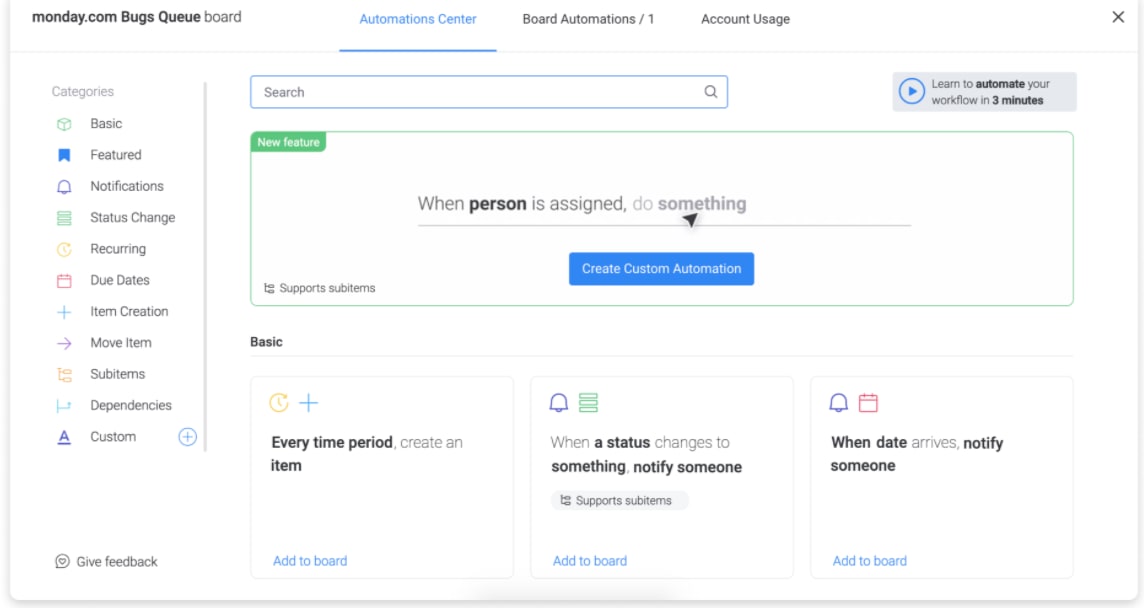
Using monday.com automations, you could, for example, build an automation that notifies you when a team member moves a project to a new phase so you don’t need to spend time looking for updates. You could also set a reminder for a reoccurring meeting or event, such as a birthday or parent teacher conference.
2. Sorting and organizing functionalities
Your planner tool should make it easy to assign priorities to various tasks and move items around as needed.
Customization options such as color-coding can help immensely, too, as it pulls the eye in the right direction. We can see in the image below that this person organized tasks by person, the task’s impact, and urgency level, so everyone knows the hierarchy.
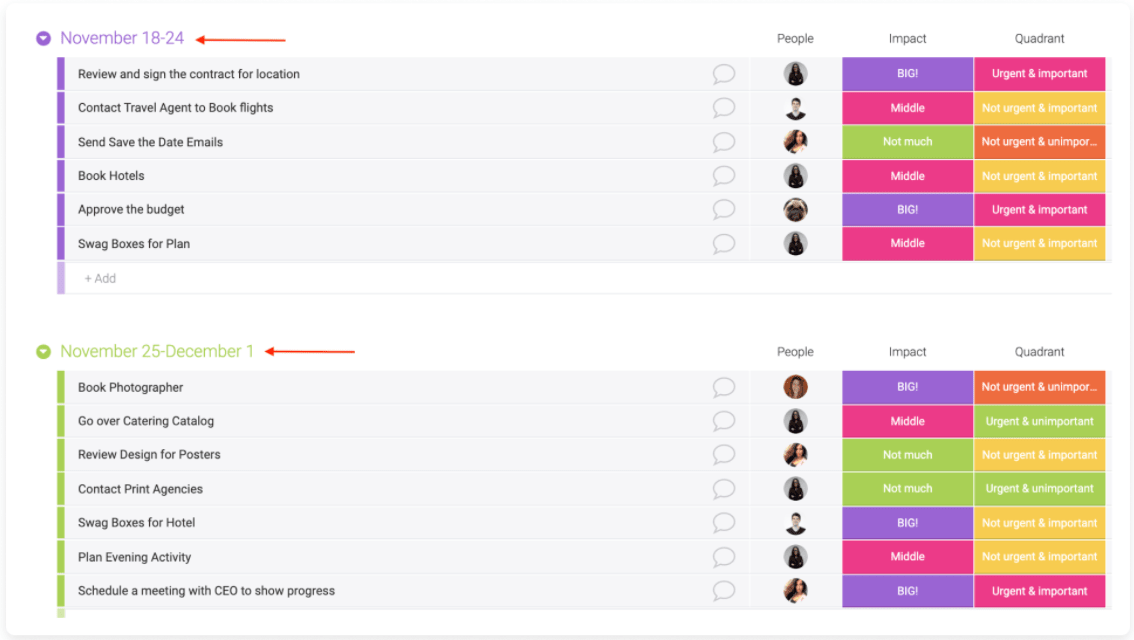
3. Several view options
You can gain different insights from the same body of information depending on what it looks like in your planner app. For example, a list view helps you see what you need to do and makes it easy to add new tasks, while a calendar view shows when things need to be done, allowing for easier task and project prioritization.
Thus, your planner app should provide different views you can switch between with one click. For instance, monday.com offers several views that contextualize all kinds of information:
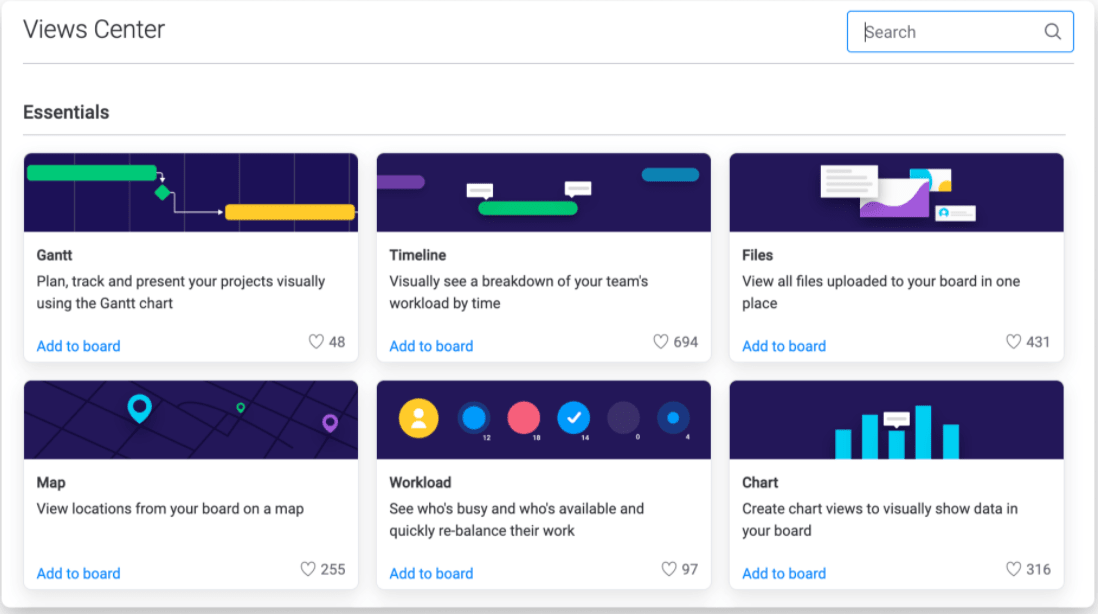
Multiple views allow you to see tasks and to-dos in a way that makes sense for you. This makes it adaptable to all kind of teams, which brings us to our last benefit.
4. Integrations with other apps you love
The more software your planner app can integrate with, the better because you’ll still be able to work with the tools you already love, but on one software, reducing the amount of app-jumping required.
For example, monday.com integrates with Google Drive, Dropbox, OneDrive and Box (ps we also integrate with Google Calendar!), so you can import files directly onto your shared workspace.
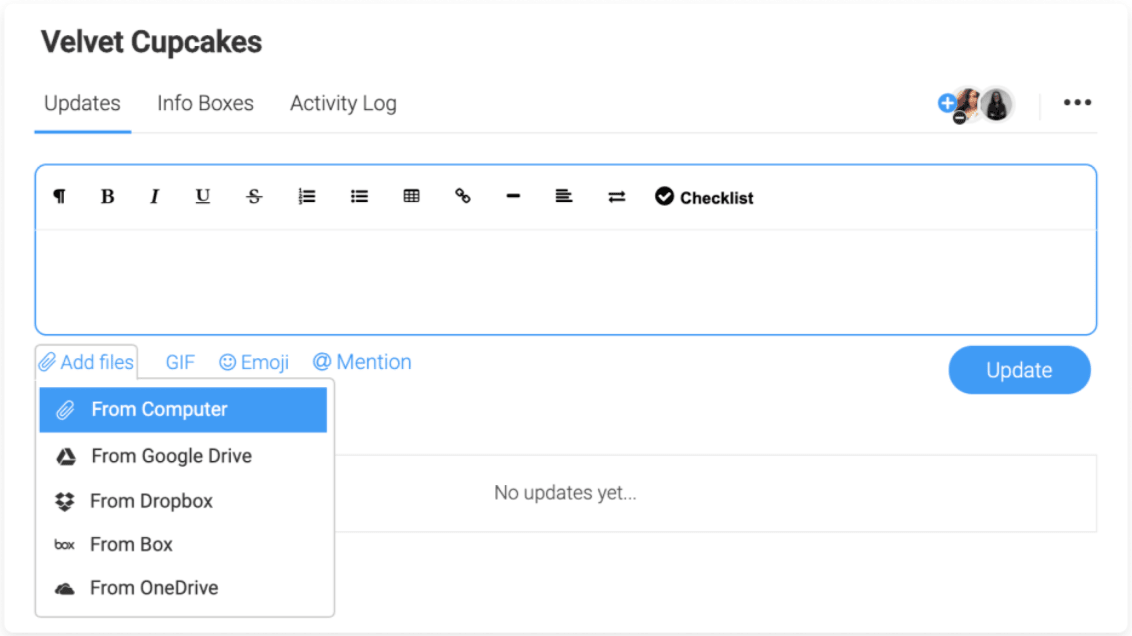
Build a custom planner app with monday.com
With seemingly endless customization options, monday.com offers numerous ways to create your own planner app.
But with so much at your disposal, it’s sometimes challenging to know where to begin. That’s why monday.com provides pre-made templates you can build off of.
First is the My Focus personal digital planner tool, which helps you stay on top of your own work and goals. It’ll sync with your calendar and help you sort assigned items into your monday.com workspace.
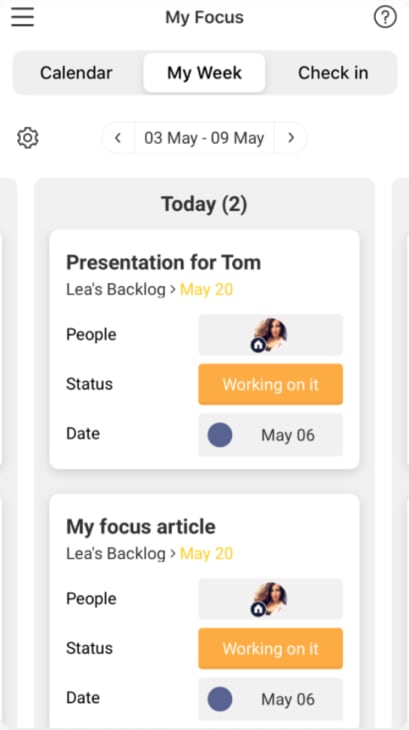
One notable feature is the Daily Check-Ins that include automated questions such as “What do you hope to accomplish today?” keeping you motivated and on task.
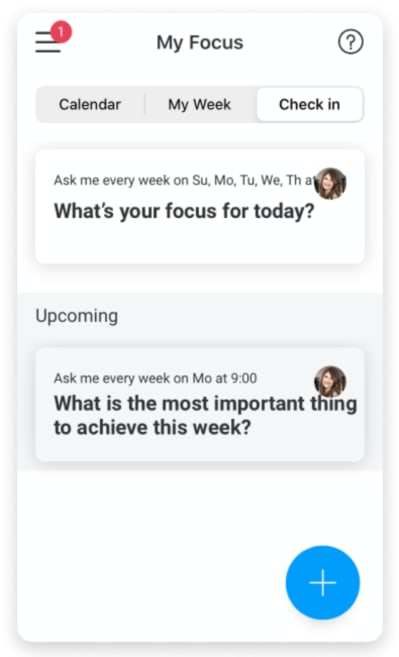
My Focus works well for individual tasks, but when you need a planner for your team or organization, monday.com offers plenty of ready-to-go board templates.
For example, if your team needs a weekly planner, this Team Task Management template comes with color-coded options for task prioritization, a status column, and more.
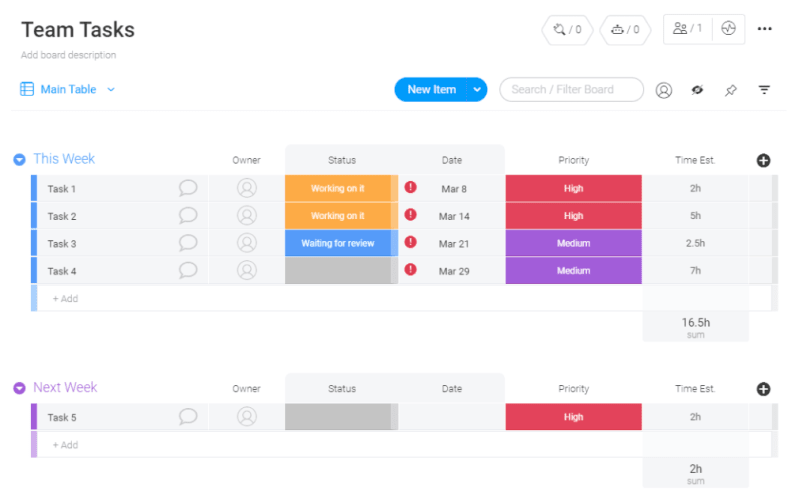
Just select the template, make your modifications, and you’re good to go.
For those of you needing a planner for personal use, we didn’t forget about you. Busy college students, for example, can make use of this Student Organizer template that organizes dates, assignments, statuses, and progress.
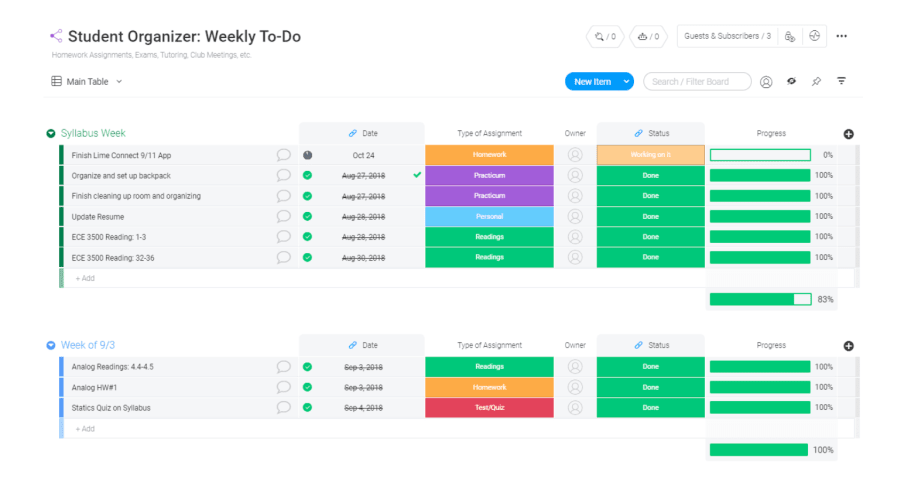
You can effortlessly create a student planner app, juggle classes, study sessions, group projects, club meetings, and parties with ease.
Last but not least, you can build entire apps within the monday.com platform using a low-code and no-code framework.
From whiteboards that offer a collaborative space for brainstorming to online docs where you can edit, view, and collaborate on external docs within monday.com, any app you imagine, you can create.
Plan your tasks for success
Planner apps are productivity lifesavers, helping you cut down on your stress and improve time management.
Make sure the solution you choose has the features you need, like automation and integrations.
Better yet, consider a Work OS like monday.com that lets you build the exact planner app you need — and use it alongside the rest of your workflows.

